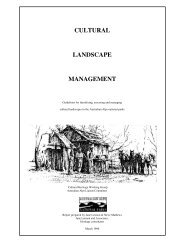The Population Ecology of Wild Horses in the Australian Alps
The Population Ecology of Wild Horses in the Australian Alps
The Population Ecology of Wild Horses in the Australian Alps
Create successful ePaper yourself
Turn your PDF publications into a flip-book with our unique Google optimized e-Paper software.
1994). In <strong>the</strong> longer-term, heavy snow events may become less frequent if global<br />
warm<strong>in</strong>g raises mean temperatures <strong>in</strong> <strong>the</strong> <strong>Australian</strong> <strong>Alps</strong> (Whetton 1998). Such<br />
changes may facilitate <strong>the</strong> expansion <strong>of</strong> <strong>the</strong> distribution <strong>of</strong> wild horses.<br />
Drought <strong>in</strong>fluences <strong>the</strong> distribution <strong>of</strong> wild horses <strong>in</strong> <strong>the</strong> ra<strong>in</strong>shadow area on <strong>the</strong> eastern<br />
side <strong>of</strong> <strong>the</strong> <strong>Australian</strong> <strong>Alps</strong> south <strong>of</strong> J<strong>in</strong>dabyne. <strong>The</strong>re is very little water available <strong>in</strong> this<br />
environment <strong>in</strong> contrast to <strong>the</strong> rest <strong>of</strong> <strong>the</strong> <strong>Alps</strong> where water is freely available. In 1982-<br />
83 drought killed <strong>of</strong>f most <strong>of</strong> <strong>the</strong> horses <strong>in</strong> <strong>the</strong> area and kangaroo, wallaby and rabbit<br />
populations also suffered massive losses.<br />
<strong>The</strong> potential <strong>of</strong> behaviour to limit <strong>the</strong> distribution <strong>of</strong> wild horses is difficult to assess.<br />
<strong>The</strong>y are highly social animals and <strong>the</strong>re is a general belief that <strong>the</strong>y are strongly tied to<br />
<strong>the</strong>ir home range. Behaviour, environmental events (e.g. drought, snow, fire) and o<strong>the</strong>r<br />
species (eg wild dogs) may have acted <strong>in</strong> conjunction with humans to restrict <strong>the</strong><br />
expansion <strong>in</strong> range <strong>of</strong> wild horses by keep<strong>in</strong>g <strong>the</strong>m below a threshold density. If wild<br />
horses are similar to wood bison <strong>in</strong> that <strong>the</strong>y are pulse dispersers, <strong>the</strong>y must reach a<br />
threshold density before <strong>the</strong>y disperse and colonise a new area.<br />
It will be <strong>in</strong>terest<strong>in</strong>g to see <strong>the</strong> patterns <strong>of</strong> wild horse distribution <strong>in</strong> <strong>the</strong> <strong>Australian</strong> <strong>Alps</strong><br />
<strong>in</strong> <strong>the</strong> future. It is likely to depend heavily on <strong>the</strong> approach to management. If <strong>the</strong>y are<br />
not actively managed <strong>the</strong>y may disperse <strong>in</strong>to new areas. Alternatively, management<br />
may result <strong>in</strong> a range reduction. <strong>The</strong> low rate <strong>of</strong> spread <strong>of</strong> wild horses <strong>in</strong> <strong>the</strong> <strong>Australian</strong><br />
<strong>Alps</strong> should make <strong>the</strong>m relatively easy to manage compared to o<strong>the</strong>r <strong>in</strong>troduced species<br />
such as <strong>the</strong> European rabbit which spread at 64km per year (Caughley 1977).<br />
Abundance<br />
<strong>The</strong> goals <strong>of</strong> manag<strong>in</strong>g wild animal populations are usually expressed <strong>in</strong> terms <strong>of</strong><br />
population size. For endangered species, managers try to <strong>in</strong>crease population size, for<br />
pest species <strong>the</strong>y try to reduce population size and for harvested populations <strong>the</strong>y try to<br />
ma<strong>in</strong>ta<strong>in</strong> a population size to optimise harvest. <strong>Population</strong> estimates are particularly<br />
useful if <strong>the</strong>y are repeated through time. <strong>Population</strong> trend data is useful for assess<strong>in</strong>g<br />
<strong>the</strong> success <strong>of</strong> management actions or response <strong>of</strong> <strong>the</strong> population to natural events. I<br />
used aerial survey to estimate <strong>the</strong> size <strong>of</strong> <strong>the</strong> wild horse population <strong>in</strong> <strong>the</strong> <strong>Australian</strong><br />
<strong>Alps</strong> national parks <strong>in</strong> 2001. I repeated this survey <strong>in</strong> 2003 after <strong>the</strong> fires (refer to Walter<br />
2003 for details).<br />
Despite <strong>the</strong> obvious advantages <strong>of</strong> us<strong>in</strong>g aerial survey to estimate abundance and<br />
density <strong>of</strong> animals, it has many shortcom<strong>in</strong>gs. One <strong>of</strong> <strong>the</strong> challenges is to improve<br />
accuracy, which is a measure <strong>of</strong> how close a population estimate is to true population<br />
size. Undercount<strong>in</strong>g is <strong>the</strong> rule <strong>in</strong> aerial surveys, so results usually are negatively<br />
biased. Some <strong>of</strong> <strong>the</strong> ma<strong>in</strong> factors contribut<strong>in</strong>g to bias are vegetation cover, species be<strong>in</strong>g<br />
surveyed, survey specifications (e.g. height above ground, speed, strip width), wea<strong>the</strong>r<br />
conditions and observer experience. <strong>The</strong>re are several analysis techniques frequently<br />
used for aerial survey <strong>in</strong>clud<strong>in</strong>g strip surveys (used extensively <strong>in</strong> kangaroo surveys),<br />
mark-recapture models (used on emus and mule deer), and l<strong>in</strong>e transect models (a<br />
newer technique which is prov<strong>in</strong>g to be very useful). In this study I used all three<br />
6

















